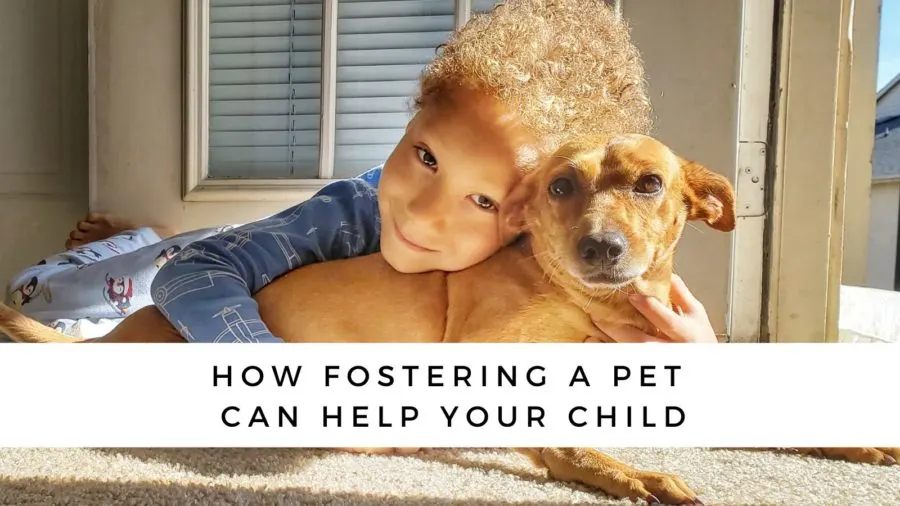Fostering animals is a vital way for shelters and rescues to be successful taking in more animals and saving more lives. Just in time for National Foster a Pet Month, we have a guest post about how fostering not only helps the shelter and the adoptable pet but how fostering a pet can help your child as well!
When is National Foster a Pet Month?

National Foster a Pet Month is always in June. The pet awareness month is an initiative of Petco Love.
“Ending preventable euthanasia of shelter pets is possible today,” said Susanne Kogut, president of Petco Love. “Data tells us that if we could encourage 2% more of the 85-million pet-owning households to foster just one pet a year, we can eliminate preventable euthanasia and save the lives of the 800,000 shelter animals at risk of euthanization.”
How Fostering a Pet Can Help Your Child

In our age of digital everything, parents are often desperate for ideas for activities that will tear their kids’ attention away from their electronics. One great option may be as close as the nearest animal shelter or rescue.
Animal welfare organizations are constantly in need of individuals and families to foster pets. Fostering is essentially caring for a pet in your home temporarily until a forever home is found for the pet. All types of pets need fostering, from dogs and cats, to puppies and kittens to rabbits, guinea pigs, birds and more.
Fostering Saves Lives
And fostering literally saves animals’ lives.
There are an estimated 1.5 million pets unnecessarily euthanized in shelters in the United States each year (source: ASPCA).
Fostering pets is an activity an increasing number of families have found to be a great activity that benefits both the pets and the kids. Some families foster for a few days, and some for a few months, depending on the family’s schedule. And, most organizations pay for supplies and veterinary care for the pet.
Here are a few reasons why fostering is a great option for families with kids:
Contributing to the Greater Good
While some parents may worry their kids will get too attached to a foster pet and not want to give them up, it’s all about positioning, says Caroline Golon, whose family fosters several litters of kittens every summer.
“Of course we want to keep them all! But we go into a foster situation talking a lot about how important of a job we have to do – to prepare the kittens for their forever families – and by letting them go to families who will love them, we’re doing the best thing for animals in general because then we can help more kittens. My daughters, who are 8 & 10, embraced that concept and it’s worked well for us.”
Warm and Fuzzy Companionship
Because activities with screens have infiltrated our every day lives in nearly every way, caring for animals is the quintessential break from those glowing screens.
Dogs need to be walked, cats need to be played with, and pet-related chores require hands on focus. And don’t forget about the furry snuggles! Talk about the polar opposite of cold, hard electronics!
A Job to Do
Kids of all ages can gain experience and learn responsibility while caring for foster pets. From giving them a loving, safe home, to taking care of feeding, watering and walking or scooping litter boxes, caring for a pet is a bit of work.
But even beyond the daily “chores,” much of what families with kids can bring to fostering is the opportunity to socialize the animals and learn about them so they can land in the perfect home.
Pets, no matter what age, benefit from being around kids so the foster family can report to potential adopters how the animal’s temperament is.
Socialization is one of the big things kids bring to the equation. If a pet thrives on lots of attention from children, that’s a great thing to know.
Timid pets can come out of their shell around kids. On the flip side, pets that don’t enjoy attention from kids can be adopted into a home without children.
Animal welfare organizations learn so much about the animal and what’s best for him or her by having families foster.
Service Hours
With many high schools across the nation requiring service hours from their students, parents are constantly helping their kids look for volunteer opportunities that qualify.
Nancy Fay of San Antonio, Texas was shocked when she discovered the time her daughter had spent fostering numerous pets for the City of San Antonio Animal Care Services would translate to service hours.
“I was so surprised and excited to learn that fostering counted towards service hours. I’ve been spreading the word because it’s such a great experience for the kids and so critical for the animals,” she said. Fay’s daughter ended up with 2,000 service hours for the fostering she had done over a span of several years.
Broward County Animal Shelter in Fort Lauderdale, Florida specifically recruits teens to care for kittens and puppies that are too young for shelter life, according to the Sun Sentinel.
Broward High has mandatory 40 hours of service hours required for students to graduate. The shelter gives the students everything they need to foster.
Fostering a pet for just two weeks can earn the student their required number of hours. Of course, parental permission is required for the job, but students are expected to do the care.
Fostering is an easy way to make an impact on animal welfare in our country.
Pin It to Remember How Fostering a Pet Can Help Your Child

- Selecting the Best Online Emotional Support Animal Letter Service - December 14, 2023
- How to Store Dog Toys –10 Solutions to Organize Those Toys! - July 7, 2022
- Best Practices to Puppy-Proof Your Home - June 27, 2022
